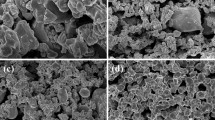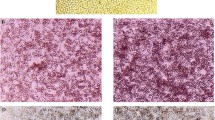Abstract
Electrical potentials in mechanically loaded bone have been implicated as signals in the bone remodeling cycle. Recently, interest has grown in exploiting this phenomenon to develop electrically active ceramics for implantation in hard tissue which may induce improved biological responses. Both polarized hydroxyapatite (HA), whose surface charge is not dependent on loading, and piezoelectric ceramics, which produce electrical potentials under stress, have been studied in order to determine the possible benefits of using electrically active bioceramics as implant materials. The polarization of HA has a positive influence on interfacial responses to the ceramic. In vivo studies of polarized HA have shown polarized samples to induce improvements in bone ingrowth. The majority of piezoelectric ceramics proposed for implant use contain barium titanate (BaTiO3). In vivo and in vitro investigations have indicated that such ceramics are biocompatible and, under appropriate mechanical loading, induce improved bone formation around implants. The mechanism by which electrical activity influences biological responses is yet to be clearly defined, but is likely to result from preferential adsorption of proteins and ions onto the polarized surface. Further investigation is warranted into the use of electrically active ceramics as the indications are that they have benefits over existing implant materials.









Similar content being viewed by others
References
Baxter, F. R., I. G. Turner, C. R. Bowen, J. P. Gittings, and J. B. Chaudhuri. An in vitro study of electrically active hydroxyapatite-barium titanate ceramics using Saos-2 cells. J. Mater. Sci. Mater. Med. 20(8):1697–1708, 2009.
Beloti, M. M., P. T. de Oliveira, R. Gimenes, M. A. Zaghete, M. J. Bertolini, and A. L. Rosa. In vitro biocompatibility of a novel membrane of the composite poly(vinylidene-trifluoroethylene)/barium titanate. J. Biomed. Mater. Res. 79A(2):282–288, 2006.
Best, S., A. Porter, E. Thian, and J. Huang. Bioceramics: past, present and for the future. J. Eur. Ceram. Soc. 28(7):1319–1327, 2008.
Black, J. Biological Performance of Materials: Fundamentals of Biocompatibility. Boca Raton: CRC Taylor & Francis, 2006.
Bodhak, S., S. Bose, and A. Bandyopadhyay. Electrically polarized HAp-coated Ti: in vitro bone cell–material interactions. Acta Biomater. 2009. doi:10.1016/j.actbio.2009.08.008.
Callegeri, B., and W. D. Belangero. Analysis of the interface formed among the poli (viniilidene) fluoride (piezoelectric and non piezoelectric) and the bone tissue of rats. Acta Orthop. Bras. 12(3):160–166, 2004.
Cowin, S. C., and M. L. Moss. Mechanosensory mechanisms in bone. In: Bone Mechanics Handbook, edited by S. C. Cowin. Boca Raton: CRC Press, 2001.
Cowin, S., S. Weinbaum, and Y. Zeng. A case for bone canaliculi as the anatomical site of strain generated potentials. J. Biomech. 28(11):1281–1297, 1995.
Davies, J. E. The importance and measurement of surface charge species in cell behaviour at the biomaterial interface. In: Surface Characterisation of Biomaterials, edited by R. D. Ratner. Amsterdam: Elsevier, 1988.
Dekhtyar, Y., N. Polyaka, and R. Sammons. Electrically charged hydroxyapatite enhances immobilization and proliferation of osteoblasts. 14th Nordic-Baltic Conference on Biomedical Engineering and Medical Physics, Vol. 20. Berlin, Heidelberg: Springer, 2008.
Feng, H. An investigation on the ceramic composite of the biological piezoelectric implants. In: Polymers and Biomaterials. Amsterdam: Elsevier, 1991.
Feng, J., H. P. Yuan, and X. D. Zhang. Promotion of osteogenesis by a piezoelectric biological ceramic. Biomaterials 18(21):1531–1534, 1997.
Finke, B., F. Luethen, K. Schroeder, P. D. Mueller, C. Bergemann, M. Frant, A. Ohl, and B. J. Nebe. The effect of positively charged plasma polymerization on initial osteoblastic focal adhesion on titanium surfaces. Biomaterials 28(30):4521–4534, 2007.
Frost, H. M. A. 2003 update of bone physiology and Wolff’s Law for clinicians. Angle Orthod. 74(1):3–15, 2004.
Fukada, E., and I. Yasuda. On the piezoelectric effect of bone. J. Phys. Soc. Jpn. 12(10):1158–1162, 1957.
Fukada, E., and I. Yasuda. Piezoelectric effects in collagen. Jpn. J. Appl. Phys. 3(2):117–121, 1964.
Gimenes, R., and M. A. Zaghete. Composites PVDF-TrFE/BT used as bioactive membranes for enhancing bone regeneration. Smart Structures and Materials 2004: Electroactive Polymer Actuators and Devices, San Diego, USA, 2004.
Hastings, G. W., and F. A. Mahmud. The electromechanical properties of fluid-filled bone: a new dimension. J. Mater. Sci. Mater. Med. 2(2):118–124, 1991.
Hench, L. L. Bioceramics. J. Am. Ceram. Soc. 81:1705–1728, 1998.
Hwang, K. S., J. E. Song, J. W. Jo, H. S. Yang, Y. J. Park, J. L. Ong, and H. R. Rawls. Effect of poling conditions on growth of calcium phosphate crystal in ferroelectric BaTiO3 ceramics. J. Mater. Sci. Mater. Med. 13(1):133–138, 2002.
Itoh, S., S. Nakamura, M. Nakamura, K. Shinomiya, and K. Yamashita. Enhanced bone ingrowth into hydroxyapatite with interconnected pores by Electrical Polarization. Biomaterials 27(32):5572–5579, 2006.
Jee, W. S. S. Integrated bone tissue physiology: anatomy and physiology. In: Bone Mechanics Handbook, edited by S. C. Cowin. Boca Raton: CRC Press, 2001.
Jeong, J. H., I. J. Kwak, H. I. Kim, J. L. Ong, H. R. Rawls, and Y. J. Park. The 81st General Session of the International Association for Dental Research. Goteberg, Sweden, 2003.
Kieswetter, K., Z. Schwartz, T. W. Hummert, D. L. Cochran, J. Simpson, D. D. Dean, and B. D. Boyan. Surface roughness modulates the local production of growth factors and cytokines by osteoblast-like MG-63 cells. J. Biomed. Mater. Res. 32(1):55–63, 1996.
Kizuki, T., M. Ohgaki, M. Katsura, S. Nakamura, K. Hashimoto, Y. Toda, S. Udagawa, and K. Yamashita. Effect of bone-like layer growth from culture medium on adherence of osteoblast-like cells. Biomaterials 24(6):941–947, 2003.
Kobayashi, T., S. Itoh, S. Nakamura, M. Nakamura, K. Shinomiya, and K. Yamashita. Enhanced bone bonding of hydroxyapatite-coated titanium implants by electrical polarization. J. Biomed. Mater. Res. 82A(1):145–151, 2007.
Kobayashi, T., S. Nakamura, and K. Yamashita. Enhanced osteobonding by negative surface charges of electrically polarized hydroxyapatite. J. Biomed. Mater. Res. 57(4):477–484, 2001.
Li, J., D. Liu, H. Z. Ke, R. L. Duncan, and C. H. Turner. The P2X7 nucleotide receptor mediates skeletal mechanotransduction. J. Biol. Chem. 280(52):42952–42959, 2005.
Li, Z., Y. Qu, X. Zhang, and B. Yang. Bioactive nano-titania ceramics with biomechanical compatibility prepared by doping with piezoelectric BaTiO3. Acta Biomater. 5(6):2189–2195, 2009.
Ma, G. B., and X. Y. Liu. Hydroxyapatite: Hexagonal or monoclinic? Cryst. Growth Des. 9(7):2991–2994, 2009.
Macginitie, L., G. D. Stanely, W. A. Beiber, and D. D. Wu. Bone streaming potentials and currents depend on anatomical structure and loading orientation. J. Biomech. 30(11–12):1133–1139, 1997.
Maeda, H., K. Tsuda, and E. Fukada. The dependence on temperature and hydration of piezoelectric, dielectric and elastic constants of bone. Jpn. J. Appl. Phys. 15(12):2333–2336, 1976.
Mahabole, M. P., R. C. Aiyer, C. V. Ramakrishna, B. Sreedhar, and R. S. Khairnar. Synthesis, characterization and gas sensing property of hydroxyapatite ceramic. Bull. Mater. Sci. 28(6):535–545, 2005.
Marino, A., J. Rosson, E. Gonzalez, L. Jones, S. Rogers, and E. Fukada. Quasi-static charge interactions in bone. J. Electrostatics. 21(2–3):347–360, 1988.
Martin, R. B. Toward a unifying theory of bone remodeling. Bone 26(1):1–6, 2000.
McElhaney, J. H. The charge distribution on the human femur due to load. J. Bone. Jt. Surg. 49A:1561–1571, 1967.
Nakamura, S., T. Kobayashi, M. Nakamura, S. Itoh, and K. Yamashita. Electrostatic surface charge acceleration of bone ingrowth of porous hydroxyapatite/beta-tricalcium phosphate ceramics. J. Biomed. Mater. Res. 2009. doi:10.1016/j.actbio.2009.08.008.
Nakamura, M., A. Nagai, Y. Tanaka, Y. Sekijima, and K. Yamashita. Polarized hydroxyapatite promotes spread and motility of osteoblastic cells. J. Biomed. Mater. Res. 2009. doi:10.1002/jbm.a.32404.
Nakamura, M., Y. Sekijima, S. Nakamura, T. Kobayashi, K. Niwa, and K. Yamashita. Role of blood coagulation components as intermediators of high osteoconductivity of electrically polarized hydroxyapatite. J. Biomed. Mater. Res. 79A(3):627–634, 2006.
Nakamura, S., H. Takeda, and K. Yamashita. Proton transport polarization and depolarization of hydroxyapatite ceramics. J. Appl. Phys. 89(10):5386–5392, 2001.
Nijweide, P. J., E. H. Burger, J. K. Nulend, and A. Van der Plas. The osteocyte. In: Principles of Bone Biology, edited by J. Bilezikian, Z. Raiz, and T. J. Martin. London: Academic Press, 1996.
Ohgaki, M., T. Kizuki, M. Katsura, and K. Yamashita. Manipulation of selective cell adhesion and growth by surface charges of electrically polarized hydroxyapatite. J. Biomed. Mater. Res. 57(3):366–373, 2001.
Parek, B., M. Joshi, and A. Vaidya. Characterization and inhibitive study of gel-grown hydroxyapatite crystals at physiological temperature. J. Cryst. Growth 310(7–9):1749–1753, 2008.
Park, J. B., B. J. Kelly, G. H. Kenner, A. F. von Recum, M. F. Grether, and W. W. Coffeen. Piezoelectric ceramic implants: in vivo results. J. Biomed. Mater. Res. 15(1):103–110, 1981.
Park, J. B., A. F. von Recum, G. H. Kenner, B. J. Kelly, W. W. Coffeen, and M. F. Grether. Piezoelectric ceramic implants: a feasibility study. J. Biomed. Mater. Res. 14(3):269–277, 1980.
Qiu, K., X. J. Zhao, C. X. Wan, C. S. Zhao, and Y. W. Chen. Effect of strontium ions on the growth of ROS17/2.8 cells on porous calcium polyphosphate scaffolds. Biomaterials 27(8):1277–1286, 2006.
Raisz, L. G. Physiology and pathophysiology of bone remodeling. Clin. Chem. 45(8 Pt 2):1353–1358, 1999.
Schumacher, D., U. Gross, and V. Strunz. Does piezoceramic influence avian bone formation in the early postoperative phase? Biomaterials 4(3):215–217, 1983.
Seeley, R. R., T. D. Stephens, and P. Tate. Anatomy and Physiology. Boston: McGraw Hill, 2003.
Shimono, T., S. Matsunaga, E. Fukada, T. Hattori, and Y. Shikinami. The effects of piezoelectric poly-L-lactic acid films in promoting ossification in vivo. In Vivo 10(5):471–476, 1996.
Sikavitsas, V. I., J. S. Temenoff, and A. G. Mikos. Biomaterials and bone mechanotransduction. Biomaterials 22(19):2581–2593, 2001.
Silva, C. C., A. F. L. Almeida, R. S. de Oliveira, A. G. Pinheiro, J. C. Góes, and A. S. B. Sombra. Dielectric permittivity and loss of hydroxyapatite screen-printed thick films. J. Mater. Sci. 38(18):3713–3720, 2003.
Takeda, H., S. Nakamura, K. Yamada, T. Tsuchiya, and K. Yamashita. Dielectric properties of poled hydroxyapatite ceramics. Key Eng. Mater. 181–182:35–40, 2000.
Tofail, S. A. M., D. Haverty, F. Cox, J. Erhart, P. Hána, and V. Ryzhenko. Direct and ultrasonic measurements of macroscopic piezoelectricity in sintered hydroxyapatite. J. Appl. Phys. 105(6), 2009.
Tofail, S. A. M., D. Haverty, K. T. Stanton, and J. B. McMonagle. Structural order and dielectric behaviour of hydroxyapatite. Ferroelectrics 319:117–123, 2005.
Turner, C. H. Three rules for bone adaptation to mechanical stimuli. Bone 23(5):399–407, 1998.
Wang, W., S. Itoh, Y. Tanaka, A. Nagai, and K. Yamashita. Comparison of enhancement of bone ingrowth into hydroxyapatite ceramics with highly and poorly interconnected pores by electrical polarization. Acta Biomater. 5(8):3132–3140, 2009.
Wolff, J. D. Der gesetz der transformation der knochen. Berlin: A. Hirschwald, 1892.
Xia, Z., and J. T. Triffitt. A review on macrophage responses to biomaterials. Biomed. Mater. 1(1):R1–R9, 2006.
Yamashita, K., K. Kitagaki, and T. Umegaki. Thermal instability and proton conductivity of ceramic hydroxyapatite at high temperatures. J. Am. Ceram. Soc. 78(5):1191–1197, 1995.
Yamashita, K., N. Oikawa, and T. Umegaki. Acceleration and deceleration of bone-like crystal growth on ceramic hydroxyapatite by electric poling. Chem. Mater. 8(12):2697–2700, 1996.
Yamashita, K., H. Owada, T. Umegaki, T. Kanazawa, and T. Futagami. Ionic conduction in apatite solid solutions. Solid State Ionics 28–30(1):660–663, 1988.
Zhu, P., Y. Masuda, and K. Koumoto. The effect of surface charge on hydroxyapatite nucleation. Biomaterials 25(17):3915–3921, 2004.
Author information
Authors and Affiliations
Corresponding author
Additional information
Associate Editor Michael S. Detamore oversaw the review of this article.
Rights and permissions
About this article
Cite this article
Baxter, F.R., Bowen, C.R., Turner, I.G. et al. Electrically Active Bioceramics: A Review of Interfacial Responses. Ann Biomed Eng 38, 2079–2092 (2010). https://doi.org/10.1007/s10439-010-9977-6
Received:
Accepted:
Published:
Issue Date:
DOI: https://doi.org/10.1007/s10439-010-9977-6




